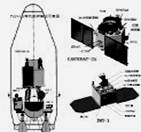As we know, it is not easy to build a satellite(卫星). Building a traditional satellite usually takes years. The costs can be as high as $250 million or more. Most members of the design teams have worked in the field for a long time. They hold advanced degrees(学历) in math, science, or engineering.

But things are changing. High costs, unusual educational needs and long start-up times are no longer an obstacle(障碍) to space exploration. The scientists have developed a new type of tiny, inexpensive earth-orbiting(轨道) satellite.
So far, college students have built and launched(发射) several cube-shaped satellites, or CubeSats. At least 15 more are ready to go. Those already in orbit take pictures, collect information and send it back to the earth, just as regular satellites do.
But you might not even have to wait until you get to college to start designing and building your own satellite. A new program called KatySat aims to get teenagers to take part in. When kids understand what satellites can do, the kinds of ideas they’ll come up with may be countless.
Education isn’t the only aim of CubeSats because these tiny, technology-filled boxes are inexpensive to build and can be put together quickly, they’re perfect for testing new technologies that might one day be used on major space tasks.
The biggest challenge now is to find ways to bring the satellites back to the earth after a year or two. Or space junk could gradually increase because CubeSats become more popular.
Nowadays, college and high school students are getting a chance to learn what it takes to explore in space. Someday—perhaps a lot sooner that you imaging—you might get to design, build and launch your own satellite. If you do, you’re sure to have fun. And you might also get crazy about science for life.
小题1:Building a traditional satellite __________.
A. costs $250,000
B. needs college students
C. takes quite a long time
小题2:Compared with the traditional ones, the new satellites __________.
A. need long start-up times
B. are cheap and small-sized
C. collect more junk in orbit
小题3:The underlined word “countless” in Paragraph 4 probably means “__________”.
A. 无用的 B. 无价值的 C. 无数的
小题4:According to the passage, which of the following is true?
A. CubeSats could possibly cause pollution in space.
B. Scientists designed CubeSats for kids to play with.
C. Students can’t design satellites without college education.
小题5:The purpose of the author writing the passage is __________.
A. to tell us that satellite technology can also be learned by kids
B. to show that high technology brings a big change in kids’ life
C. to tell us that kids must study hard to learn satellite technology